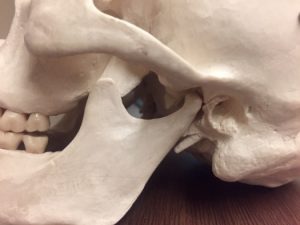
In difficult times, we are often told to “keep a stiff upper lip” or “keep your chin up”. I think that we all recognize that jaw clenching and tooth gnashing are common reactions to stress. Clenching the jaw and grinding the teeth can result in a broad range of symptoms ranging from jaw pain, facial muscle fatigue, neck pain, headaches or “TMD”. Collectively, this spectrum of symptoms may be referred to as “craniofacial pain”.
In this post I will provide information and suggestions that to help you relieve jaw pain from the comfort of your home.
Some Background Info to Bite Into
First, let me address the often-misused term “TMJ” or “TMD”. Many people refer to pain around the jaw as “TMJ”. The abbreviation “TMJ” simply means “temporomandibular joint”. We all have two. It is the area where the mandible (lower jaw bone) meets the skull and forms a joint.
On the other hand “TMD” refers to “Temporomandibular joint disorder”. TMD is a general term that describes a broad range of disorders that may lead to jaw pain, noises and locking.
The most commonly encountered origin of craniofacial pain is often related the muscles around the jaw and neck. The underlying cause if frequently jaw clenching, known as “bruxism”. Jaw clenching not only activates the muscles used to chew, but also causes contraction of the muscles in the neck and upper back.
I often tell my patients that jaw function begins in the upper back. Why is this? In order to chew, the muscles of the neck and upper back need to stabilize the head on the neck. So, when a person clenches, the muscle of the neck and upper back may become tense.
Why the Tight Jaw?
If jaw muscle clenching is part of the problem, what is the solution? First, let’s dive a little deeper and understand some causes of bruxism.
Stress and Anxiety – It is our natural tendency to keep a stiff upper lip or hold our chin up. Just think of how many times that you clench your jaw closed and growl in your mind (and maybe even out loud) when under stress. Clenching commonly worsens at night. If you wake feeling tightness in the jaw and temples, chances are you are subconsciously clenching at night. For some people, this can be so severe that bits and pieces of tooth powder are worn off. Others even fracture teeth. The underlying cause of this clenching could be related to stress, or even sleeping position.
Sleep disorders – Sleep apnea and sleep apnea devices may cause abnormal strain on the TMJ and the muscles that control it.
Tooth misalignment – Malocclusion of the teeth can lead to tightening of the jaw muscles as you subconsciously try to find a resting place for your jaw. Some people require adjustments to their bite (shaving down of teeth) in order to stabilize their bite. This as a last resort effort. I recommend that my patients avoid adjustments to their natural teeth, particularly if the misalignment was the result of dental restoration procedures.
Some Jaw Dropping Solutions
First, some simple, general tips
- Maintain good posture. Forward head carriage may contribute to clenching of the jaw. Read my last post for tips.
- Don’t lean your head and jaw against your hand.
- Don’t sleep on your stomach.
- Avoid chewing gum, hard candy and ice cubes.
- Hold your jaw in the resting – “Lips together, teeth apart.”
What about stress?
Now is a great time to incorporate meditation and mindfulness practices into your life. At any given point in your day, pause and pay attention to where you are holding muscle tension. Are you grasping your steering wheel with all your might? Are you tightening your back muscles just sitting upright? Pay particular attention to the jaw, neck and upper back.
Now, take in a deep breath through your nose, exhale through your mouth and let those tense muscles release. I use a technique referred to as “Box breathing” and find it very effective.
Here is how to box breathe:
- Through your nose, take in a slow deep breath, to a count of 4.
- Hold for 4 seconds.
- Slowly exhale through your mouth to a count of 4.
- Hold for 4 seconds.
- Repeat 4 times.
Is there anything that you can do about nighttime clenching?
I recommend a bedtime routine of hot packs, massage and stretching. This entire process will require fewer than 20 minutes. First, lay back and wrap a hot pack around your face and jaw for 10-15 minutes.
Next, use some facial/body lotion and apply it to the skin above and below the cheekbones. Using the middle knuckles of your hands, apply deep pressure to the muscle beneath the cheekbone (masseter muscle) and stroke downward toward the corner of your jaw several times. Then, simultaneously apply the same pressure while opening the jaw. Click here for a handout of this procedure.

To relax the temporalis muscle, use the pads of your thumbs and compress in above the cheekbones. In a fanlike pattern, massage along the temples. Then, do the same while opening the jaw several times. Click here for the technique.

When you are feeling the temporalis and masseter muscles, if you locate tight spots in the muscles, apply deep pressure to them. There will be some discomfort during the compression, but it will slowly dissipate. As the discomfort dissipates, add progressively more pressure for about a minute.
Whether sleeping on your back or side, maintaining support under the neck is important. When side sleeping, roll up a pillow and position it under the neck in such a way that it supports the jaw. If you look up “Jackson Cervipillo” on Amazon.com, you will see several comfortable pillow options.
Enter sleep using a progressive relaxation technique; a body scan, or even box breathing. Some people find that taking 400 mg Magnesium Citrate has a mild muscle relaxing effect. You might also add a cup of Chamomile or Tulsi tea to the bedtime routine.
Do Mouthguards Work?
There a few different types of mouthguards with different purposes and constructed of various materials. For example, two broad categories are hard and soft guards.
Some mouthguards are designed to simply protect the teeth and may do a great job at it. Others are designed to stabilize the occlusion of the teeth (improve the way the teeth fit together). Some may even do both. Soft mouthguards may cause a person to clench even more though, even though they protect the teeth. Most guards that modify occlusion are firm and are custom made. The cost of custom guards may cost hundreds, or even thousands of dollars. Many of my patients have responded favorably to the “Aqualizer” splint, which is a cost conscious alternative to a custom guard. I recommend trying all of the above strategies prior to proceeding to a custom mouth guard.
Lastly, don’t keep your mouth shut about craniofacial pain. Do just the opposite. Throughout the day, stretch your mouth wide open. Yawn frequently. You can even help it along with a stretch like this:

Until next time,
Matthew H Kowalski, DC
Chiropractor and Associate Clinical Director
Osher Clinical Center at Brigham and Women’s Hospital
850 Boylston Street, Suite 422
Chestnut Hill, MA 02467
617-732-9700










